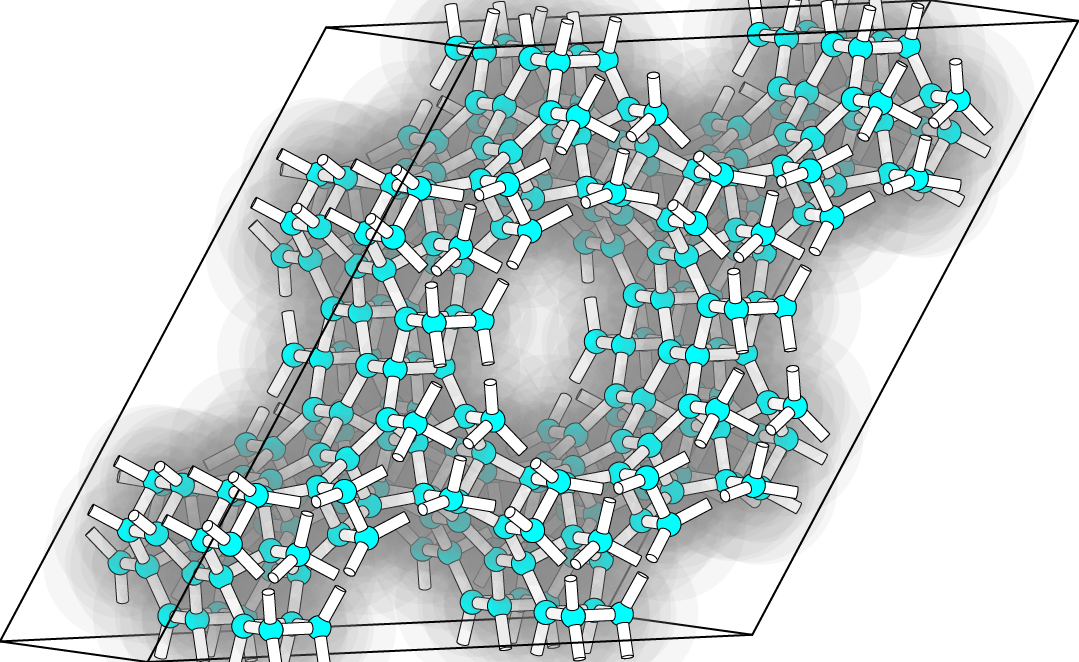How to make hot ice
水の凍る温度(凝固点)を変えるにはどうしたらいいでしょうか? 何も混ぜなければ、水を冷やすと0℃で氷になりますが、塩やアルコールを混ぜることで、凍る温度をもっと低くすることは簡単にできます。塩を混ぜても、塩水が凍る時には塩が吐きだされて真水の氷ができることを利用して、水を凍らせて海水を淡水化しよう、というアイデアもありますが、淡水を作りたい地域は一般に気温が高いため、0℃以下まで水を冷やすためのエネルギーが馬鹿にならず、実用化には至っていません。
では、凍る温度を0℃よりも高くするには? 例えば、水が凍る温度を15℃ぐらいにできれば、ほどよく冷たくて、しかも冷たさが長持ちする氷枕を作ることもできるはずです。淡水を作る場合もで、より高い温度で凍らせられれば、冷凍のためのエネルギーをずいぶん節約できます。でも、凍る温度を上げるのは、下げるのに比べてかなり難しいのです。
水の凍る温度を上げるためには、通常の氷(雪と同じ六角形)とは異なる結晶構造に凍らせる必要があります。例えば、7千気圧以上加えれば、氷の結晶構造が変化して融点が0℃よりも高くなります。また、加圧しながらメタンと水をいっしょに凍らせると、複雑な結晶構造をもつメタンハイドレートができて、その凍る温度は(圧力によっても変わりますが)0℃より少し高くなります。常圧で水に有機溶媒の一種のテトラヒドロフラン(THF)を混ぜた場合にも、凝固点は4℃ぐらいまで上昇し、臭化テトラブチルアンモニウムと呼ばれる物質を水に混ぜると、凝固点は10℃以上にまで上がります。いずれの場合も、結晶構造は普通の氷とは違ったものになります。
しかし、加圧するためには余分なエネルギーが必要ですし、毒性のあるテトラヒドロフランや臭化テトラブチルアンモニウムを使った場合には、それらを除去しなければ淡水として利用できません。水に混ぜ物をせずに、凝固点を高くする方法はないのでしょうか。
私たちの研究室では、氷の結晶構造がゼオライトと呼ばれる無機結晶の構造に似ていることに注目し、さまざまな新しい結晶構造の氷を作る方法を計算機シミュレーションで模索してきました。そのなかで、円筒状の空洞をもつ氷dtcが比較的安定であること、これをさらに安定にするには、空洞に何か別の分子を入れてやればよいことをつきとめました。カーボンナノチューブと呼ばれる、非常に細い針金状の分子を一定間隔でならべたナノブラシを作り、その間に水を流し入れると、水は氷dtcの構造に凍り、その凝固点は最高で50℃にもなることが計算機シミュレーションにより予測されました。(論文YYMT2019)
凝固点を越えると、ナノチューブの間に入った水は融けますが、ナノブラシ自体は固体なので、テトラヒドロフランや臭化テトラブチルアンモニウムのように水に溶けこむことはなく、簡単に淡水を得ることができます。また、ナノチューブの太さや間隔を調節することで、水の凍る温度を自由に調節できます。
本研究では、固体表面を使って、水の凝固点を高くできることを初めて示しました。今のところ、ナノブラシを精密に形成する技術がないのですぐには実用化できませんが、将来は温度を自由に設定できる保冷剤や、熱帯地方での海水の淡水化に役立つと考えられます。
How can I change the freezing temperature of water (freezing point)? If you don’t mix anything, the water will turn into ice at 0°C when you cool it, but you can easily lower the freezing temperature by mixing it with salt or alcohol. One idea is to use the fact that salt is ejected when salt water freezes to desalinate seawater by freezing the water. However, since the temperature is generally high in regions that want to make fresh water, the energy required to cool the water to below 0 ° C is not negligible and has not been put into practical use.
How do you make the freezing temperature of ice higher than 0°C? For example, if you can freeze water at 15 degrees, you can make an ice pillow that cools down confortably and lasts longer. If you make fresh water and freeze it at a higher temperature, you can save a lot of energy for freezing. But raising the freezing temperature is much more difficult than lowering it.
To increase the freezing temperature of water, it is necessary to freeze the water into a crystal structure different from that of normal ice. For example, if 7000 atm or more is added, the crystal structure of ice changes and the melting point becomes higher than 0°C. When methane and water are frozen together under pressure, methane hydrate with a complex crystal structure is formed and its freezing temperature is slightly higher than 0°C (depending on the pressure,). The freezing point of water mixed with tetrahydrofuran (THF), an organic solvent, at atmospheric pressure also rises to about 4°C, and mixing water with a substance called tetrabutylammonium bromide raises the freezing point to above 10°C. In either case, the crystal structure is different from normal ice.
However, extra energy is required for pressurization, and when toxic tetrahydrofuran or tetrabutylammonium bromide is used, it cannot be used as fresh water without removing them. Is there any way to raise the freezing point without mixing water?
In our laboratory, we focused on the fact that the crystal structure of ice is similar to that of inorganic crystals called zeolites, and have been searching for ways to make ice with various new crystal structures by computer simulation. We have found that ice dtc, which has cylindrical cavities, is relatively stable. To make it more stable, we need to put some other molecule into the cavity. A computer simulation predicted that when water is poured into a nano brush made of very thin wiry-shaped molecules called carbon nanotubes arranged at regular intervals, the water freezes into the structure of ice dtc, and its freezing point can reach as high as 50°C.
Beyond the freezing point, the water between the nanotubes melts, but since the brushes themselves are solid, they do not dissolve in water like tetrahydrofuran or tetrabutylammonium bromide, and fresh water can be easily obtained. You can also adjust the diameter and spacing of the nanotubes to control the freezing temperature of the water.
In this study, we demonstrated for the first time that a solid surface can be used to increase the freezing point of water. At present, there is no technology to precisely form the nano-brush, so it cannot be put into practical use immediately. In the future, however, it will be useful for ice packs with freely adjustable temperatures and desalination of seawater in tropical regions.

Figure 1 Structure of ice dtc. / 氷dtcの結晶構造。水分子を球で、水素結合を棒で表現している。

Figure 2 Ice dtc frozen in the nanbrush. / ナノブラシの間で水が凍って生じた氷dtc。
YYMT2019 氷dtc ice water research 氷dtc 雑記 2019-08-28